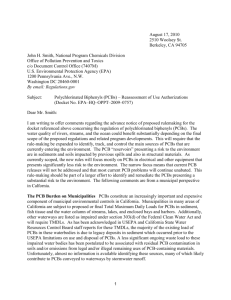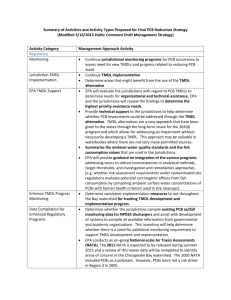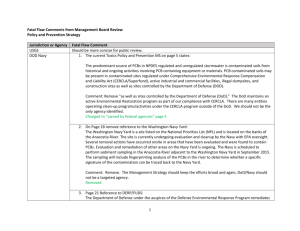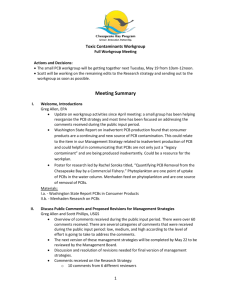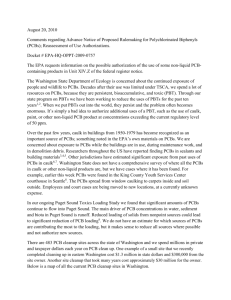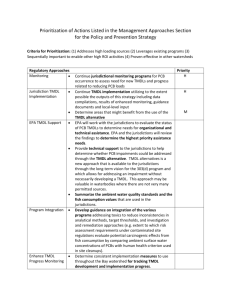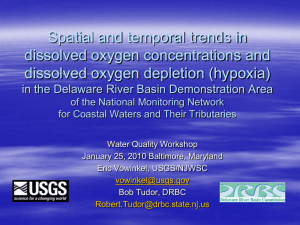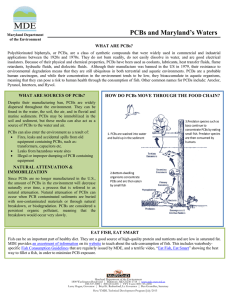tcw_12-18-14_pp_summary_final
advertisement
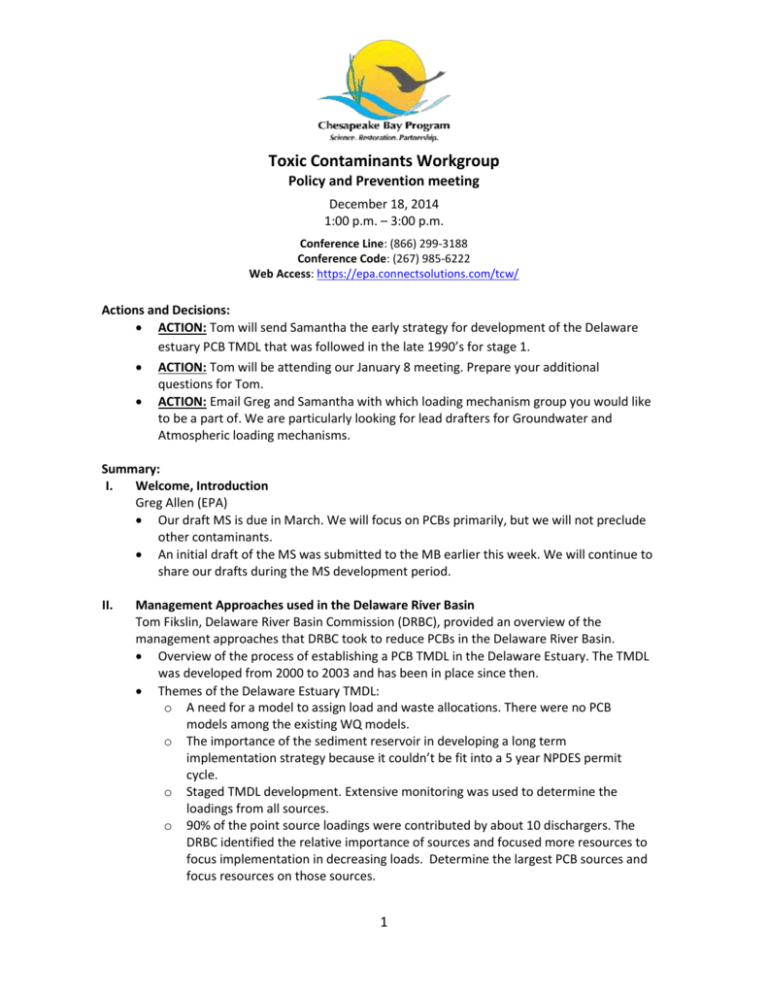
Toxic Contaminants Workgroup Policy and Prevention meeting December 18, 2014 1:00 p.m. – 3:00 p.m. Conference Line: (866) 299-3188 Conference Code: (267) 985-6222 Web Access: https://epa.connectsolutions.com/tcw/ Actions and Decisions: ACTION: Tom will send Samantha the early strategy for development of the Delaware estuary PCB TMDL that was followed in the late 1990’s for stage 1. ACTION: Tom will be attending our January 8 meeting. Prepare your additional questions for Tom. ACTION: Email Greg and Samantha with which loading mechanism group you would like to be a part of. We are particularly looking for lead drafters for Groundwater and Atmospheric loading mechanisms. Summary: I. Welcome, Introduction Greg Allen (EPA) Our draft MS is due in March. We will focus on PCBs primarily, but we will not preclude other contaminants. An initial draft of the MS was submitted to the MB earlier this week. We will continue to share our drafts during the MS development period. II. Management Approaches used in the Delaware River Basin Tom Fikslin, Delaware River Basin Commission (DRBC), provided an overview of the management approaches that DRBC took to reduce PCBs in the Delaware River Basin. Overview of the process of establishing a PCB TMDL in the Delaware Estuary. The TMDL was developed from 2000 to 2003 and has been in place since then. Themes of the Delaware Estuary TMDL: o A need for a model to assign load and waste allocations. There were no PCB models among the existing WQ models. o The importance of the sediment reservoir in developing a long term implementation strategy because it couldn’t be fit into a 5 year NPDES permit cycle. o Staged TMDL development. Extensive monitoring was used to determine the loadings from all sources. o 90% of the point source loadings were contributed by about 10 dischargers. The DRBC identified the relative importance of sources and focused more resources to focus implementation in decreasing loads. Determine the largest PCB sources and focus resources on those sources. 1 Achieved reductions were maintained by utilizing an action level, which had a purpose to elicit a prompt response to elevated PCB concentrations. Lana Sindler, Wash COG: What were the methods used to remove PCBs from the superfund sites? o At one site, a wall was created to prevent tidal exchange from the wetland. The soil was removed and taken off site to a disposal area. At another site, hot spots were removed from a transformer recycling facilities and did some capping. Both sites continue to be monitored. Lana Sindler, Wash COG: Was the TMDL penta-PCB based or was it for all PCBs? o The expert panel determined that one of the homologs would be used and we could extrapolate that across the entire reach of the river. Roughly 25% of all PCBs were penta, so we used penta to model and we scaled it up to get total PCBs. Mark Richards, VA DEQ: We’ve found that contaminated sites are still contributing a significant amount even after they have been cleaned up. What have you done about this? o We ran into the same problems. We found that the removal of the 40,000 lb of PCBs on one site was really do to active intervention with the state who was dealing with the responsible authority. A lot of this involved being more active. A task force of state and EPA people identified the sites that could potential contributors, ranked the various sites, and saw significant reductions by focusing on heavily contaminated sites. o Delaware has a report for this effort. John sent this to Greg. Dave Montali, WV DEP: It sounds like larger more industrial sites have contributed to the progress. What have the municipalities done to make progress? o Municipalities are participating in track down studies. These have been successful and they typically involve going within your system, identifying different sources (particularly indirect dischargers), and sampling where you saw highest concentration. Cities of Camden and Wilmington have participated in track down studies. Tom Fikslin, DRBC: The biggest implementation success has been in finding problem sources and developing pre-treatment. Tracking hot spot sources and using some control authority to lower those loads (e.g., MS4s). Rather than a very broad problem, we are identifying areas that we can focus resources on to get significant reductions as everyone works to identify PCBs and reduce them. Dennis McMenamin, DHS: Were any of the NPL superfund sites already closed when you engaged them? o A lot of the sites were already closed. One was a disposal area that was used by an active oil refinery (not on their property, but was used in the past as a disposal site). Another site was a RCRA site that was a transformer recycling facility that went out of business in 1979. Another site was an Amtrak maintenance yard that has point source discharges as well as contaminated soil. We have more success on individual sites. Lana Sindler, Wash COG: One of the creeks had high PCB concentrations in Philadelphia. What did they do? How did they do the cleanup? o That’s their next step. As part of their 5 year MS4 permit, we are now dealing with them to bring together both groups. The next step is to do more refined sampling at the tributaries and identify sources more specifically. Mark Richards, VA DEQ: Atmospheric deposition and fluxing you observed is local. What is that due to? What are the sources of air contamination? 2 o III. There is a major regional contamination of PCBs, and the air monitoring network that we set up showed us that the highest concentration was found near scrap metal recycling facilities. LJ Ingram, Chart, LLC: Has DRBC put together a specific management strategy document? o Our outreach to the regulatory community and environmental groups has documentation and we have an appendix that we’re preparing for the stage 2 report. o ACTION: Tom will send Samantha the early strategy for development of the Delaware estuary PCB TMDL that was followed in the late 1990’s for stage 1. o On the DRBC website, there is a link regarding data quality objectives, electronic data deliverables, and resources for PCBs that we gathered from different sources (e.g., serial numbers on PCB containing equipment). ACTION: Tom will be attending our January 8 meeting. Prepare your additional questions for Tom. Management Strategy Development Framework Discussion of the organizational approach to developing the management strategy. Review of the initial rough draft of the Policy and Prevention management strategy. The current efforts section will be organized by PCB loading mechanism and workgroup members volunteered to be the principle drafters for each of these loading mechanism sections. There is no limit on length, but sections must be concise. Appendices can be utilized to maintain a concise management strategy. Loading Mechanism section volunteer assignments: o Stormwater - Dinorah Dalmasy and Len Schugam o Wastewater - Mark Richards and Jamie Mitchell (will work with other wastewater entities) o Groundwater - Principle drafter needed. Lindsay Dodd will support, but cannot lead. o Atmospheric - Principle drafter needed. o In stream sediments - LJ Ingram and George Onyullo o Combined Sewer Overflows – need to decide whether this is its own category or can be included in wastewater o CERCLA sites - Lorie Baker (strategy on how to identify sources where it relates to contaminated soils) Workgroup members are encouraged to join a loading mechanisms group or take the lead in drafting one of the sections that does not yet have a lead (i.e., groundwater and atmospheric). ACTION: Email Greg and Samantha with which loading mechanism group you would like to be a part of. We are particularly looking for lead drafters for Groundwater and Atmospheric loading mechanisms. Attendance: Greg Allen, EPA CBPO Lindsay Dodd, MD-DE Agribusiness Mark Richards, VA DEQ Samantha Watterson, CRC LJ Ingram, Chart, LLC George Onyullo, DDOE 3 Tom Barron, PA DEP John Schneider, DE DNREC Bruce Michael, MD DNR Lorie Baker, EPA R3 HSCD Jamie Mitchell, HRSD David Flores, Blue Water Baltimore Lana Sindler, Wash COG Marel King, CBC Dev Murali, DDOE Dennis McMenamin, DHS Tom Fikslin, DRBC Dave Montali, WV DEP Sherm Garrison, MD DNR Dinorah Dalmasy, MDE 4
